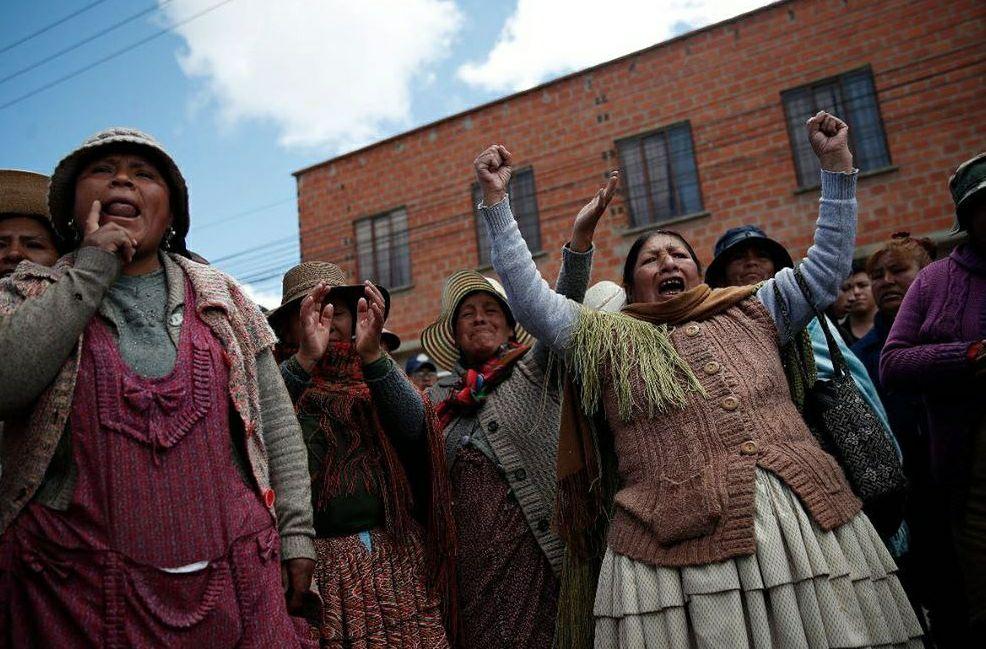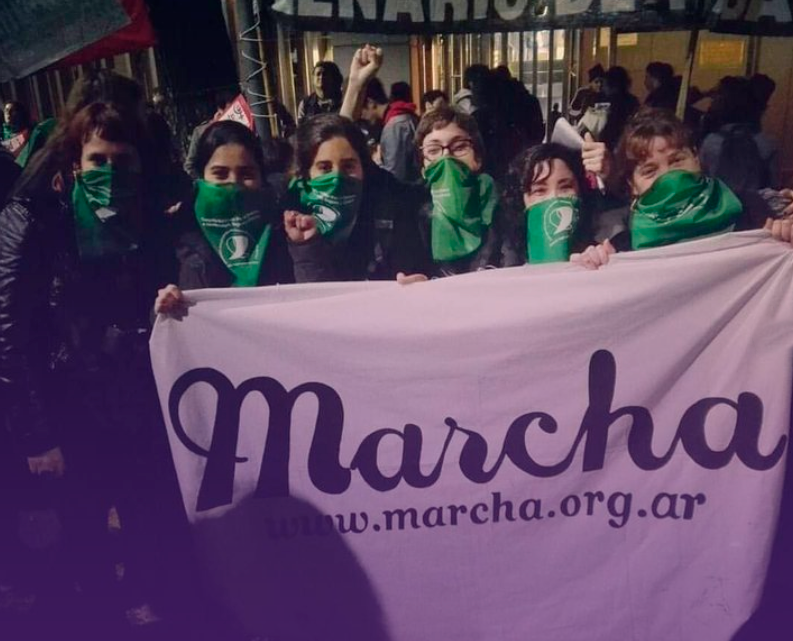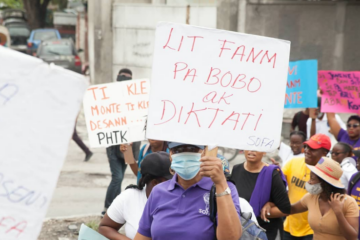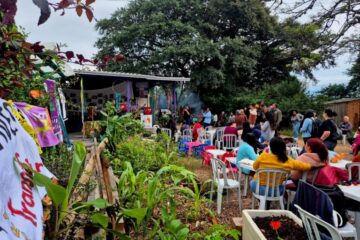Through grassroots feminist journalism, we are building a network-based ethics and practice based on dialogue. This ethics challenges the international journalism we have been taught, personified as a man working behind a desk with no contact with territories, sisters, and comrades.
I come from the Marcha portal, a grassroots media outlet. We emerged more than 11 years ago. Our process somehow weaves together what we have been building, which we call “collective journalism.” We did not come from mainstream media or a media company—we come from social movements.
Marcha emerges from the Darío Santillán Popular Front, built after the murder of two political leaders—two piqueteros, as we say in Argentina—who were blocking road accesses to the city in 2022. The unemployed workers’ movement had been carrying the weight of more than 12 years of neoliberal policies and staging pickets, blocking roads, burning tires, and blocking the access to major cities that hold and control power and political decision-making. Amid this context, the police murdered two grassroots militants: Darío Santillán and Maximiliano Kosteki.
This is how the movement named after Darío was born, and so did part of what Marcha is—which, at that time, was in charge of the communication efforts of the Front. In this process, discussing with sisters and learning about other experiences, we understood how important it is to have an autonomous media outlet while also maintaining a position and a political stance.
Feminist Lessons
At that time, the collective editorial board of Marcha had two sections—a national and an international one—, in an attempt to mimic big media outlets and provide a grassroots perspective to what they stated. We started a section called “Crime” [“Policial”], for example, but later said, “No, this is not what we want.” We want to talk about the criminalization of protests and youth, and we realized that we could absolutely not use the same category used by hegemonic outlets, and this is what sets us apart.
Our word travels, our word dances, our word “marches,” because we are part of and we play a major role in the political actions that we experience with the broad sector of grassroots movements and organizations.
At first, our gender section had a vision incorporated into the section of national topics. Because of our sisters’ major struggle, in 2014 we decided to have a specific section for it, which we called “a room of one’s own.” The gender section allowed us to diversify views and speak with leaders who previously were not very often put in this position of being a reference in the “national” section, because we usually interviewed male leaders, male directors, the men who were the points of references.
As we built a specific section in 2014, we were excited about the possibility of becoming a grassroots feminist outlet—and we have built ourselves as such. We were not going to be restricted to the gender section, with no dialogue. We wanted to share our points of view, make them transversal across international, national, cultural stories, etc. But we needed a room of our own to be able to talk among us, to see what kinds of violence were happening in community spaces and follow the process of sisters who work in media companies under much more hostile relationships.
So we moved toward feminist journalism. We did not want to talk about “gender” only, or do “women’s journalism.” We wanted a feminist perspective to pervade through other perspectives—otherwise, we would be doing this extremely interesting work while the portal would publish: “Workers occupy the streets” [Trabajadores, in Spanish, is not a gender neutral word, but a masculine noun]. Are there not female workers [trabajadoras] occupying the streets? Are there not sisters and comrades in grassroots spaces? We started to make our way into other sections, in which our comrades would agree to creating a space about gender, while also feeling uneasy about where we, feminists, wanted to get.
How To Tell Women’s Stories
Through this process, we started to tell stories of violence and denunciation, speaking with survivors, and we ultimately started to tell stories of liberation. This is an enlightening perspective about our feminism: we do not want to just report violence, but we also want to follow our sisters’ processes of liberation. We want to keep on marching until all of us are free.
We want a feminist journalism that addresses grassroots journalism, but also want grassroots journalism to address feminist journalism. We want feminist journalism to have a conception of class, understanding what our peoples experience, where socioeconomic relations are addressed, in a way in which it is not isolated, looking at violence and abortion as something apart from our social, cultural, and political processes.
We asked ourselves: how can we tell these stories without revictimizing them? Some clues that we have built include: the importance of mentioning legislation, of listing the kinds of violence that are condensed in our bodies-territories, to focus on prevention, to point out those who are accountable and the public policies that should be in place, but are not.
We do not want to tell the stories of survivors to rectimize them. We want to accuse the perpetrators. We want to point out who is inflicting violence, as well as those responsible for the fact that it is committed, understanding that there is a web of relationships.
We exist in the territories, and it is important to start from there to tell our stories. Another proposal is to create defiant visual narratives. When an attacker commits an act of violence against a sister, when a community is deprived of rights, we will not publish a picture that revictimizes them, we will not publish a video that depicts us as being fragile. On the contrary, we will show the strength of the feminist movement, the grassroots processes out on the streets and in defense of the territories. We create a narrative that counters what hegemonic media tries to establish. We make the intersectionality of the stories we tell visible. We talk about local, situated stories to then expand them and think about them regionally.
The Sources Are Political
So who are our sources, as we present ourselves from these perspectives? We, as feminists, are our own sources. When we have any questions, when we want to speak with someone about a topic, we won’t text a male managing editor that dominates communication. We will rather establish alliances with sisters. These are sources that build bonds. Maintaining bonds also means consulting sisters beforehand about how they want to be named, if they want us to share specific information or not. Networks and algorithms cannot take away from us our ethical responsibility to take care of those sisters who share information, who are in territories that must be protected, who may even be in danger.
Expanding our sources is necessary, in the sense that any one of us can talk about the topics we want to report on. Our proposal is to always speak with feminists, in any situation.
We must dismantle the exclusionary way how journalism was built by men, by communicologists, journalists who seem to have a phone book they keep under lock and key and don’t want anyone to talk to their sources. We have been building networks, we are part of several groups of feminist journalists, we meet in many places, we share the phone numbers we have, we share how we got to someone, we offer recommendations.

In recent years, the Marcha portal has been built as journalism without borders. We have aborted neutrality, nationalities, and a number of imposed categories that were not our own. We do grassroots, feminist journalism without borders. This has marked the year 2019, with all the riots and processes of struggle we have had on our continent. We say that we have created a “feminist bunker.” We have been to Chile covering the elections, the constituent process, the plurinational meetings; we have been to Colombia, also for the elections; we have been to Bolivia exposing the coup with a feminist delegation.
This is the practice we are building today. We do no want to continue to support the idea of an analyst who speaks on behalf of the territories, who speaks for us. We do international journalism to be able to have an opinion about everything that is going on in the world, to create networks, and to have our sisters deciding when is the moment to report on the news.

Camila Parodi is a feminist journalist and member of the Marcha portal. This is an edited version of her participation in the Zarelia Festival 2022.




